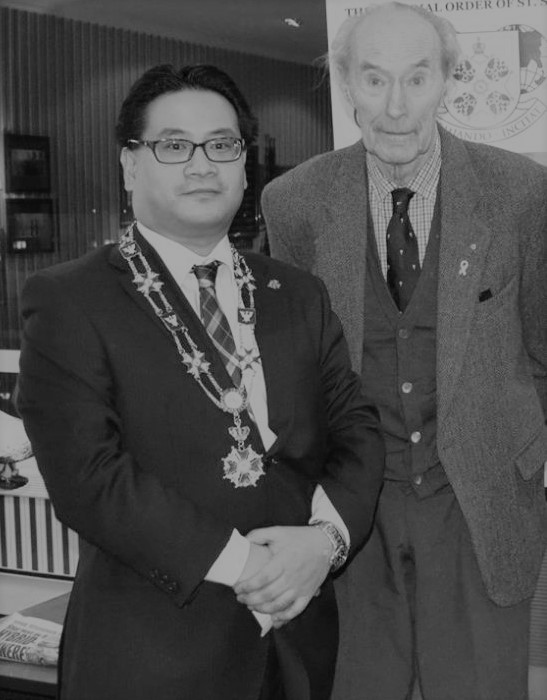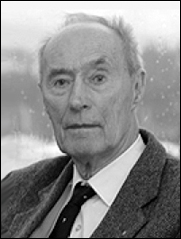
Chevalier Rønneberg was on the 9th December 2014 kl.17: 00 appointed as Honorary Knight of the order of St. Hallvard. The appointments happened at Rica Park Hotel in Ålesund in the Polarbjørn meeting room, on the ninth floor overlooking Ålesund.
Chevalier Rønneberg is apppointed Honary Knight of the Order for his effort during WWII.
Chevalier Rønneberg was born in Borgund, in Ålesund as the second son of Alf Rønneberg from Ålesund and Anna Krag Sandberg. He was the brother of Erling Rønneberg, who was a well-known resistance member too, having received British commando training.
On the maternal side he was a nephew of Ole Rømer Aagaard Sandberg, and thus a grandnephew of Ole Rømer Aagaard Sandberg, Sr. On the paternal side he was a distant descendant of Carl Rønneberg, and a grandnephew of politician Anton Johan Rønneberg, whose mother was a part of the Holmboe family—hence Joachim’s middle name.

When World War II broke out when Chevalier Rønneberg was a young adult, and Norway was occupied by Germany from April 1940. He joined Norwegian Independent Company 1 (NOR.I.C.1) (Norwegian: Kompani Linge) in 1941, having escaped Norway by boat to Scotland the same year. He received military training in the United Kingdom, and held the rank of Second Lieutenant.
The Heavy water sabotage:
The Vemork hydroelectric plant in 1935. The heavy water was produced in the front building (the Hydrogen Production Plant).
Chevalier Rønneberg, now a First Lieutenant, led the six-man Operation Gunnerside team, reinforcing the five-man team Grouse sent in earlier, during the heavy water sabotage action. After landing at a location 45 kilometres (28 mi) from the other team Gunnerside spent five days waiting out an intense blizzard in an uninhabited hunting cabin before meeting up with Grouse. The combined Norwegian team went into action against the Norsk Hydro heavy water production plant in Vemork, Norway in 1943, parachuting into the Hardangervidda plateau on 16 February.
Chevalier Rønneberg led the demolition team when the saboteurs, on the night of 27/28 February 1943, entered the Norsk Hydro plant and set explosive charges. The team then escaped from the factory as the explosives went off, without the German guards discovering the saboteurs or indeed noticing that there had been an attack on the plant, probably believing that the heavy snow had set off one of their own land mines. Although chased by 2,800 German troops five of the saboteurs, led by Chevalier Rønneberg escaped safely to neutral Sweden by way of a 14-day march over a distance of 400 kilometres (250 mi) after the successful completion of their mission.
The six other members of the sabotage team hid out in various locations in Norway without being caught by the Germans. Eighteen heavy water cells and around 500 kilograms (1,100 lb) of heavy water was destroyed during the attack, as well as a loss of production of 400 kilograms (880 lb) of heavy water.
After the factory was reported to have been rebuilt in the summer of 1943 a new saboteur attack was planned, but eventually scrapped in favour of an air strike. On 16 November 1943 161 United States Army Air Forces B-17 and B-24 heavy bombers attacked the Vemork heavy water plant, and another 12 bombers the nitrogen plant at nearby Rjukan.
The attack had not been cleared with the Norwegian government in exile in London and led to a diplomatic crisis between the Norwegian and other Allied governments. Of particular concern for the Norwegian government was the targeting of the Rjukan nitrogen plant, as it supposedly only produced products for Norwegian agriculture. Twenty-one civilian lives were lost in the bombing raid. Following the bombing raid the Germans decided to move the production to Germany, leading to the British War Cabinet to order Norwegian saboteur Knut Haukelid to sink the Norwegian ferry SF Hydro carrying the containers of heavy water across Lake Tinnsjø. The ferry was sunk with hidden explosives on 19 February 1944, going down with 15,000 litres (3,300 imp gal) of heavy water and killing 14 Norwegian civilians, ending the struggle for the Norwegian heavy water.


